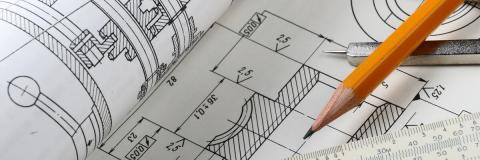

Architecture courses portfolio guide
How to put together a creative portfolio for your course
Please note
You'll need this guide if you're applying for one of the following courses:
Entry routes
Please choose your entry route to find the correct portfolio information:
Year 1 (standard entry)
Your portfolio should show your passion and skill in architecture, both creatively and non-creatively. Whether it's a project from class, an evening course, or your own creations, it's all about showcasing your journey and love for the subject.
No matter your background—be it technical, arts, science, or something entirely different—we embrace diversity in you and your portfolio.
Your portfolio is uniquely yours, reflecting your educational path. Below, you'll find some tips to help you craft it. Remember, there's no one-size-fits-all approach here.
Consider adding a personal touch to your images with a supporting statement or annotations. This helps us understand your vision and process.
Preferred output
We prefer your portfolio in PDF.
Start with a PowerPoint to easily add annotations, then convert it to PDF. Aim for at least 10 A3 pages to showcase your best work.
If you have applied for more than one course, you will need to upload your portfolio for each course choice through your applicant view (details on how to do this will be emailed to you when we request a portfolio).
What we're looking for
We're excited to see your passion and dedication to architecture or interior design shine through your portfolio. Show us your:
- Understanding of architecture or interior design, not just as a subject, but in its role in society and the world.
- Thought and creation. We're keen to see your creative process, decision-making, and any skills you can bring to the table.
- Ability to critically assess your work. What works, what doesn't, and why.
- Interest in both the history and the now of visual culture.
- Problem-solving skills and creativity in action.
Scenario 1: Traditional creative portfolio
If you're from a design or arts background, this is your arena. Your portfolio should be a gallery of your artistic prowess.
Here are some elements you can consider.
- Include your drawings and sketches that bring buildings and interiors to life.
- Dive deep into a few design projects, placing more focus on one of them.
- Show us your experimental side: your process, your sketches, your models, and how your ideas evolve.
- Don't hold back on showcasing your hands-on work—models, sculptures, or any real-world building experience.
- Technical drawings are key—let's see how they tie into your projects.
- Share your inspirations. What books, articles, exhibitions, or cultural visits have shaped your creative vision?
Scenario 2: Non-arts and design backgrounds
If you don't have a traditional arts or design background, your portfolio is a chance to show how your unique skills can apply to architecture.
Consider including:
- Examples of analytical thinking. Maybe it's visual notes, diagrams, maps, or city photography from your coursework.
- Your problem-solving and creative thinking. This could be through creative writing, project work, or any innovative coursework.
- Any hands-on experience counts. Model making, sculptures, installations, or any practical building work – we want to see it.
- Teamwork makes the dream work. Show us your collaborative projects.
- Communication is vital. Include examples of your presentation skills or public speaking.
- Show your love for architecture or interior design. Tell us about city visits, exhibitions, lectures, or workshops you've attended.
Scenario 3: Video or website
Feel free to mix it up.
Whether it's through a video, a website, or a blend of both, we're open to seeing your work in different formats. Remember, scenarios 1 and 2 are just starting points.
While AI tools can be great for sparking ideas, remember that your portfolio should reflect you. Use AI to enhance your work, but make sure your unique voice and experiences are front and centre.
Year 2/3 (direct entry)
For those directly entering Year 2/3, your digital portfolio is your ticket to show us you're ready. We're looking for a showcase of your enthusiasm and skills in visual storytelling.
Keep it concise – no more than 15 pages. Include:
- Artistic work that highlights your drawing and 'making' skills.
- Design projects that demonstrate your grasp of design concepts, processes, and three-dimensional thinking. Show us how you represent your ideas in both 2D and 3D.
I don't have a portfolio
If you have limited portfolio evidence, that's no problem.
Include an essay, report, site analysis report, or a building case study with illustrations or images. Keep it to 15 pages max.
A few final tips
- PDFs are perfect for portfolios. Consider starting with PowerPoint for easy annotation, then convert to PDF.
- Quality over quantity. Choose pieces you're proud of and that represent your best work.
- Credit your work accurately. If it's a group project, name your contributors.
- Group work is great. It shows you can collaborate, a vital skill in higher education.
- Inspired by another designer's work? That's fine. Just make sure to credit them properly.

After you apply for an undergraduate course
Once you've applied for university, there's still lots you can do while you wait for a decision on your application.
Contact us
Any questions? Contact the Faculty Student Recruitment Team.
Phone: +44 (0)23 9284 2990
Email: cci-enquiries@port.ac.uk
